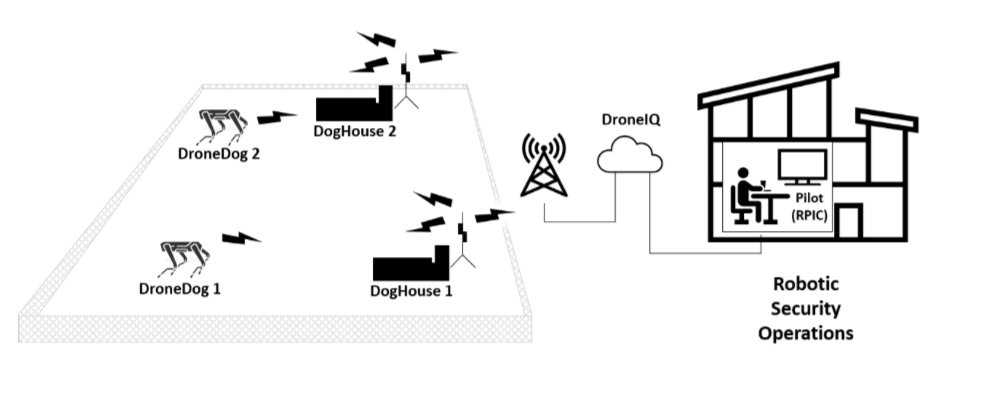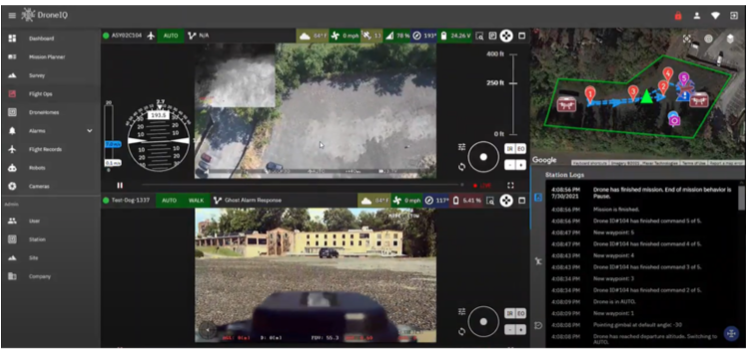Things That Make You Go H.M.M.
Human-Machine-Machine Partnering for Perimeter Security
Imagine this. It’s a dark, cold and stormy night at 2 a.m. A DroneDog, an autonomous quadruped unmanned ground vehicle (Q-UGV), spots trouble. Mission telemetry and real-time video streams from Dog through a software interface to a base-station operations center. This triggers an alarm. Within minutes, a response mission uploads and launches DroneSentry, a custom-built security unmanned aerial vehicle. The airborne DroneSentry and the ground-level DroneDog both maneuver to the area of interest and stream near real-time intelligence home from their different vantage points. The humans then make the call on next steps. Once the mission ends, both systems return to base, autonomously dock/land and settle in for the next mission.
Human-machine-machine (H.M.M.) partnering is here. And Asylon leads the way by coupling its UAV with a Q-UGV.

The DroneSentry UAV and DroneDog UGV can be complementary in changing or complex airspace.
The DroneSentry eye-in-the-sky system provides rapid response and real-time aerial situational awareness. Equipped with an advanced onboard 20x optical zoom EO/IR sensor, these drones can fly up to 35.8 miles per hour and loiter for about 25 minutes. Safety and security features include a night ops-compliant strobe, ASTM-compliant parachute recovery system, an ADS-B receiver-only capability and data encryption. To date, DroneSentries have completed over 15,000 automated drone patrol missions for enterprise customers such as Ford and FedEx.
The company recently announced a partnership with Boston Dynamics, creators of the Spot® Q-UGV, to be its DroneDog. That said, Spot is actually an old dog, with 29 plus years of R&D behind it. Since its commercial debut in September 2019, these 4-legged canine-resembling robots have walked more than 5,000 kilometers in support of more than 500 customers worldwide.
Integrated System Advantages
Asylon’s system, holistically referred to as DroneCore, includes DroneIQ and DroneHome in addition to the RSOC, DroneSentry and DroneDog.

Asylon’s Remote integrated operations provide ground and air views critical to security operations.
DroneIQ, the company’s software, fuels the robotic hardware and links it to the base station. As security robots and drones are connected wirelessly to the DroneCore platform, it allows for easy mission plan programming and operability. A few clicks can program a security drone or quadruped robot to follow a set GPS path with manual or automated control of the EO/IR camera system. Operators can set this for a specific time each day or in response to a particular alarm being triggered.
DroneHome is the DroneSentry base station and serves as its landing and launch pad while managing key components of the automation process like environmental protection, network connectivity, command and control and processing encrypted telemetry data. It includes a patented automatic drone battery swapping and charging system that optimizes response time.
The Q-UGV offers upgraded perimeter security, as it can navigate uneven terrain and stairs while tracked or wheeled robots have difficulty. A UAV can visually cover approximately 10 times more area than a human can in a single patrol. It can also patrol five times faster, with no physical restrictions such as navigating around a building or courtyard.
“This winning combination produces unprecedented near–real-time intelligence,” explained Michael Quiroga, Asylon’s chief revenue officer, a highly regarded robotic security industries subject matter expert and an entrepreneur with more than 15 years of experience in advanced security and automation technology. “It enables decision-makers to focus on what’s most important: the tough decisions they need to make in any given situation. It was a no-brainer to select Boston Dynamics’ Spot robot as our preferred UGV platform,” he continued. “Coupling its flexibility and applicability to real-world environments with our existing autonomous systems provides human operators extremely valuable intelligence through an unbeatable air and ground combination.”
That intel, in turn, flows through the company’s Robotic Security Operations Center (RSOC), headquartered north of Philadelphia. Asylon uses the RSOC to operate robots across nine different states in three different time zones, to provide 24/7 remote monitoring. This monitoring service includes call trees and escalation rules, teleoperations and real-time mission assurance with specially trained human analysts. The company also provides end-to-end client support for maintenance, FAA compliance and, as needed, licensed on-site UAV pilots.
Karen DiMeo, CEO of AERODiMEO, has more than 30 years of experience in the aviation industry working with government, startups and Fortune 500 corporate businesses. DeMeo lauded Asylon’s forward-leaning security model. “One of the biggest challenges the UAS industry has struggled with over the past several years has been the ability to scale operations under the current FAA regulations,” she noted. “Airspace is complex, and rulemaking takes time. Asylon’s use of UGVs and a 24/7 operations center enables them to do more safely and within the current framework, while progress continues to be made on advanced regulations.
Moving Forward
In 2020, the company’s drone patrol model made waves in the federal market. The U.S. Air Force awarded Asylon two separate Phase II Small Business Innovation Research (SBIR) contracts related to it. The first, a $1 million “Truly Autonomous Systems for Optimized Sustainment and Readiness” project, will offload mundane and repetitive tasks to automation/robotics and free up defenders for higher level tasks. It provided new capabilities such as a rapid eyes-in-the-sky alarm response coupled with on-the-ground Q-UGV automated patrol missions to flow actionable data simultaneously from multiple locations to Base Defense Operations Center analysts. This project should be completed by the end of the third quarter 2021, with an anticipated follow-on indefinite delivery, indefinite quantity (IDIQ) contract to scale the system for USAF Force Protection units worldwide. The second award involved an Autonomous Drone Surveillance capability, which the USAF also awarded the company $1M to develop.
How does this integrated UAV/Q-UGV model compare to others? “It doesn’t,” said Ryan Hodgens, Asylon’s marketing director. “No one else is providing this level of capability and service for the security industry. While drones and robots aren’t necessarily new technology, with the depth of the full-stack autonomy we’ve taken things for security practitioners there really aren’t any ‘others’ to compare ourselves to at this point.”
Upcoming commercial customer deployments of the Robotic Perimeter Security will task RSOC Analysts with one-to-one UGV operations. The company has plans for a future one-to-many Q-UGV setup.
Images courtesy of Asylon.
https://insideunmannedsystems.com/things-that-make-you-go-h-m-m/